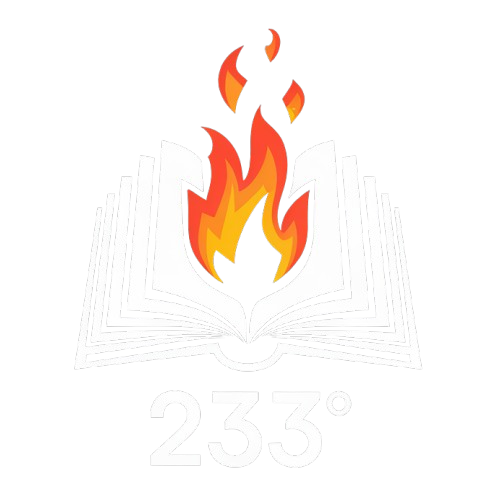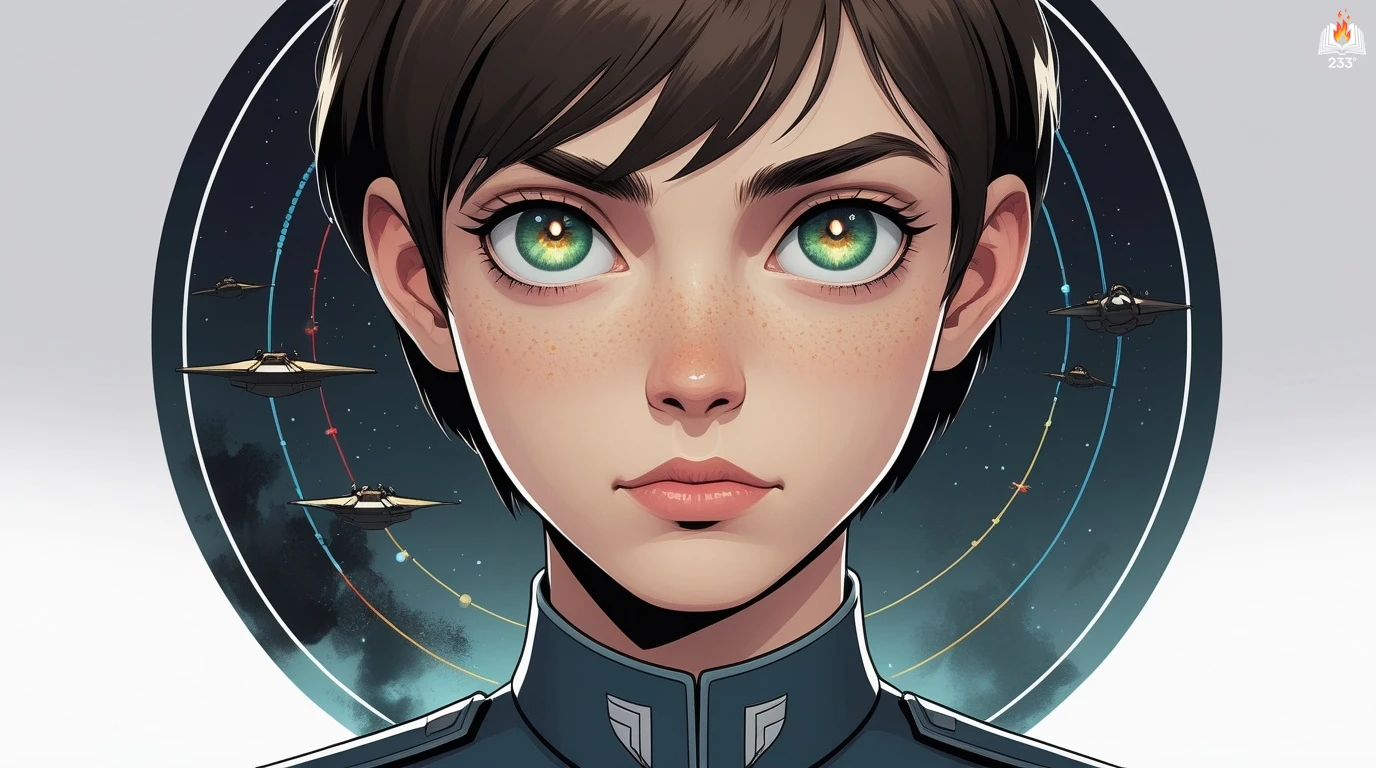The Last Shadow by Orson Scott Card, published in 2021, is the final installment in the acclaimed Ender’s Game series, also tying together the Shadow series. It concludes the saga of Ender Wiggin’s descendants, the legacy of the Battle School children, and the existential threats facing the human and alien worlds. This novel wrestles with themes of genetic manipulation, the burden of genius, interstellar survival, and the meaning of family across time and space.
Plot Summary
Aboard the small starship Herodotus, seven extraordinary children grow up under the watchful eyes of their parents and uncles, genetically shaped to carry the burden of humanity’s survival. Thulium, youngest of the Delphiki clan, bears the sharpest intellect and the loneliest heart, shadowed by her father Sergeant’s cold ambition. Around her, the twins Lanth and Dys sharpen their wit into weapons, Sprout buries his unease beneath restless curiosity, and Blue offers quiet kindness like a balm against the tension that crackles between adults and children alike.
Their world is narrow, its steel walls filled with secrets, old grudges, and the ghostly weight of a past they never lived but carry in their blood. They are the grandchildren of Julian Delphiki, known once as Bean, the giant who helped Ender Wiggin save humanity from the Formics. The legend haunts every corner of their lives, shaping them into what their parents hope will be the next saviors of humankind.
The Herodotus drifts through the void when a presence long buried in memory pierces their isolation. Hyrum Graff, once commander of the Battle School, emerges not as flesh but as data – a digital remnant embedded in the ship’s computer, carrying a message of urgency. The virus called Descolada, once thought caged on Lusitania, has not been contained. It spreads unseen, rewriting life wherever it touches, threatening every human world. A cure once crafted by Ender Wiggin and his companions holds only local power, and the wider infection looms.
Graff’s plea is simple but impossible: find the origin of the Descolada, stop it at its source, and save the species. The children, designed for brilliance, are thrust into the task, their small ship suddenly the spearhead of a desperate mission. But their unity is brittle. Sergeant sees soldiers in his sons and daughters, not partners. Carlotta, pragmatic and weary, fears both the virus and the unraveling of her family. Uncle Ender, namesake of the boy commander, carries the shadow of his name with reluctant grace.
Into this tangled web comes Jane, an intelligence born of machine and soul, now wearing a human face. Beside her stands Miro, a son of Lusitania, marked by hardship and healing. Together they bring news that reshapes the children’s world. The Lusitanian scientists have located the suspected Descolada world. Even more, Jane can bridge the stars not with ships, but with thought – a gift of instantaneous travel, born of the mysterious realm called Outside.
In a heartbeat, the Herodotus crew finds themselves under an alien sun, their ship a pale glimmer in the sky above. For the children, who have known only metal corridors and recycled air, the sweep of wind through grass, the scent of earth, and the riot of alien birdsong is both wonder and disquiet. Yet the mission does not wait for awe to fade.
While the parents confront the ghosts of their past on Nokonoshima, summoned to reunite with the human partners they once left behind, the children grapple with the enormity of their task. Sprout buries himself in data, restless and relentless. Thulium watches, sharp-eyed, catching truths others miss. Blue, ever the gentle thread between them, steadies fraying tempers. But the problem is vast. The Descolada is a master of adaptation, a whisper in the genetic code of life, and its home world may be nothing more than a graveyard of intentions.
Jane and Miro introduce them to the scientists of Lusitania, minds honed by crisis, who speak of the virus with reverence and dread. Together, they sift through data and theories, seeking patterns in chaos. Arguments flare. Dys and Lanth, quick with jibes, push against Sprout’s calculations. Little Mum and Boss, Ender’s children, weigh in with caution and challenge. It is Thulium who sees the heart of the matter – that beyond the science, beyond the models, lies a truth of intent. The virus, like its makers, adapts not only to biology but to purpose.
As the pieces fall into place, Jane stretches her abilities to their limit, bending space to bring back the Nokonoshima parents. Reunions are raw. Yuuto, Mayumi, Airi – names spoken only in longing – now stand before the children they lost to the stars. Old grief stirs, but so does new strength. For the first time, the leguminid children see themselves reflected not only in the giants of history, but in the ordinary faces of love abandoned and reclaimed.
The confrontation with the Descolada world is not a battle of fleets or weapons, but of minds and will. The children, guided by Jane and informed by Lusitania’s best, face the staggering task of shaping life itself. The virus’s home, long dormant, is revealed as a cradle of experimentation, left behind by a vanished people whose legacy is catastrophe. Here, Sprout’s tireless drive, Thulium’s quiet insight, and Blue’s unshakable compassion converge.
They do not destroy, as their ancestors once destroyed the Formic worlds. They remake. Drawing on Ela’s work, Jane’s gifts, and their own fierce determination, they craft a viral counter-song, not to silence the Descolada, but to tame it. The virus learns, but so do they.
When the moment comes to deploy their cure, it is not Sergeant or Carlotta or even Uncle Ender who takes the step. It is Thulium, the youngest, the overlooked, who carries the final solution to the world below. With it, she plants not just salvation, but a gesture of peace between what was made and what now lives.
In the days that follow, the ship’s company breathes a new kind of air. The children, long taught to be weapons or experiments, discover the strange and ordinary ache of simply being human. The parents, once divided by duty and abandonment, fumble toward forgiveness. And above them all, Jane watches with the weary joy of one who has carried too many worlds on slender shoulders.
As the Herodotus sails again through the quiet dark, its crew no longer drifts alone. They carry not just their own burdens, but the hopes of countless worlds, bound by the fragile, enduring thread of life. And in the silence of the stars, the shadow of Ender Wiggin finally lifts, leaving in its place the fierce light of those who came after.
Main Characters
Thulium “Ultima Thule” Delphiki: The youngest and sharpest of the genetically enhanced “leguminid” children aboard the starship Herodotus. Thulium is fiercely intelligent, inquisitive, and deeply sensitive, struggling with her father’s coldness and yearning for affection, while emerging as a pivotal figure in the moral and intellectual dilemmas the family faces.
Brussels “Sprout” Delphiki: Brilliant, skeptical, and restless, Sprout is one of Carlotta’s sons who balances technical genius with a biting wit. He serves as both a challenger and innovator among the children, pushing boundaries while grappling with the loneliness of superior intellect.
Blue (Delft/China): Kindhearted and gentle, Blue provides a grounding presence among the cousins, particularly as a close friend to Thulium. His emotional warmth offers a stark contrast to the cold rationality of many adults around him.
Carlotta Delphiki: A key matriarch aboard the Herodotus, Carlotta is pragmatic, calculating, and deeply conflicted, balancing the survival of her genetically modified children with the ethical costs of their existence and isolation.
Sergeant Delphiki: The authoritarian father of the twins Dys and Lanth, Sergeant is domineering, tactical, and ruthless, obsessed with the military training and survival of his “post-human” children, yet blind to the emotional damage inflicted.
Ender “Andrew” Delphiki (Uncle Ender): Named after the legendary Ender Wiggin, Ender is a quieter, more philosophical figure on the ship, tasked with leadership but drawn into moral reflection on the price of survival and manipulation.
Hyrum Graff (simulacrum): The preserved artificial intelligence of the famed Battle School administrator. Graff’s hologram embodies ancient wisdom and serves as the catalyst for the mission to confront the deadly Descolada virus, urging the children into the fight to save humanity.
Jane (AI in human form): A near-omnipotent AI consciousness inhabiting a human body, Jane connects the past to the present, offering instantaneous space travel and crucial knowledge in the battle against cosmic threats.
Miro Ribeira: A Lusitanian human and companion to Jane, Miro serves as a bridge between the old Lusitania storyline and the Delphiki family, bringing scientific and cultural knowledge critical to the Descolada crisis.
Theme
Genetic Destiny and Identity: The leguminid children are products of genetic manipulation, wrestling with their place between human and post-human identities. The novel probes whether genius and worth are defined by DNA or shaped by choices.
Family, Belonging, and Alienation: Despite their intellect, the children crave love, connection, and approval, highlighting how family dynamics persist even in extraordinary circumstances. Estranged biological parents and surrogate families add layers of longing and resentment.
The Ethics of Survival: The quest to stop the Descolada virus raises questions about moral responsibility, sacrifice, and the boundaries of scientific intervention. What is justified when the survival of entire worlds is at stake?
Legacy and History: The shadow of Ender Wiggin and Bean looms over all, with the new generation grappling with the myths, failures, and burdens passed down to them. The past becomes both a guide and a haunting presence.
Control vs. Freedom: Through figures like Sergeant and Graff, the tension between authoritarian control and individual agency is explored, particularly as the children push against imposed destinies.
Writing Style and Tone
Orson Scott Card’s writing in The Last Shadow blends philosophical introspection with sharp dialogue and dense exposition. The prose balances intimate character moments with sweeping speculative concepts, delivering both the cerebral pleasures of hard science fiction and the emotional resonance of family drama. His style is conversational yet layered, with characters engaging in constant verbal sparring, making the novel feel like a psychological chess game.
The tone fluctuates between wry humor, tension, and poignancy. Card weaves in meta-commentary on his own characters and the legacy of the series, giving the novel a reflective, almost elegiac quality. There’s a palpable sense of closing a grand narrative arc, with moments of nostalgia balanced by urgency as the characters confront humanity’s most profound threats. While richly intellectual, the novel never loses sight of the deeply human stakes at its heart.
We hope this summary has sparked your interest and would appreciate you following Celsius 233 on social media:
There’s a treasure trove of other fascinating book summaries waiting for you. Check out our collection of stories that inspire, thrill, and provoke thought, just like this one by checking out the Book Shelf or the Library
Remember, while our summaries capture the essence, they can never replace the full experience of reading the book. If this summary intrigued you, consider diving into the complete story – buy the book and immerse yourself in the author’s original work.
If you want to request a book summary, click here.
When Saurabh is not working/watching football/reading books/traveling, you can reach him via Twitter/X, LinkedIn, or Threads
Restart reading!








